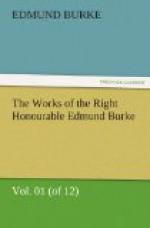SECTION XXVII.
THE SUBLIME AND BEAUTIFUL COMPARED.
On closing this general view of beauty, it naturally occurs that we should compare it with the sublime; and in this comparison there appears a remarkable contrast. For sublime objects are vast in their dimensions, beautiful ones comparatively small; beauty should be smooth and polished; the great, rugged and negligent: beauty should shun the right line, yet deviate from it insensibly; the great in many cases loves the right line; and when it deviates, it often makes a strong deviation: beauty should not be obscure; the great ought to be dark and gloomy: beauty should be light and delicate; the great ought to be solid, and even massive. They are indeed ideas of a very different nature, one being founded on pain, the other on pleasure; and, however they may vary afterwards from the direct nature of their causes, yet these causes keep up an eternal distinction between them, a distinction never to be forgotten by any whose business it is to affect the passions. In the infinite variety of natural combinations, we must expect to find the qualities of things the most remote imaginable from each other united in the same object. We must expect also to find combinations of the same kind in the works of art. But when we consider the power of an object upon our passions, we must know that when anything is intended to affect the mind by the force of some predominant property, the affection produced is like to be the more uniform and perfect, if all the other properties or qualities of the object be of the same nature, and tending to the same design as the principal.
“If black and white blend,
soften, and unite
A thousand ways, are there
no black and white?”
If the qualities of the sublime and beautiful are sometimes found united, does this prove that they are the same; does it prove that they are any way allied; does it prove even that they are not opposite and contradictory? Black and white may soften, may blend; but they are not therefore the same. Nor, when they are so softened and blended with each other, or with different colors, is the power of black as black, or of white as white, so strong as when each stands uniform and distinguished.
FOOTNOTES:
[24] Part IV. sect. 20.
[25] Part IV. sect. 23.
[26] Part IV. sect. 25.




